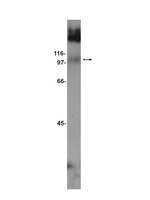Anatomy and function of group III metabotropic glutamate receptors in gastric vagal pathways.
Richard L Young,Nicole J Cooper,L Ashley Blackshaw
Neuropharmacology
54
2008
Mostra il sommario
Metabotropic glutamate receptors (mGluR) are classified into groups I (excitatory), II and III (inhibitory) mGluR. Activation of peripheral group III mGluR (mGluR4, mGluR6, mGluR7, mGluR8), particularly mGluR8, inhibits vagal afferent mechanosensitivity in vitro which translates into reduced triggering of transient lower oesophageal sphincter relaxations and gastroesophageal reflux in vivo. However, the expression and function of group III mGluR in central gastrointestinal vagal reflex pathways is not known. Here we assessed the expression of group III mGluR in identified gastric vagal afferents in the nodose ganglion (NG) and in the dorsal medulla. We also determined the central action of the mGluR8a agonist S-3,4-DCPG (DCPG) on nucleus tractus solitarius (NTS) neurons with gastric mechanosensory input in vivo. Labelling for mGluR4 and mGluR8 was abundant in gastric vagal afferents in the NG, at their termination site in the NTS (subnucleus gelatinosus) and in gastric vagal motorneurons, while labelling for mGluR6 and mGluR7 was weaker in these regions. DCPG (0.1 nmol or 0.001-10 nmol i.c.v.) inhibited or markedly attenuated responses of 8/10 NTS neurons excited by isobaric gastric distension with no effect on blood pressure or respiration; 2 NTS neurons were unaffected. The effects of DCPG were significantly reversed by the group III mGluR antagonist MAP4 (10 nmol, i.c.v.). In contrast, 4/4 NTS neurons inhibited by gastric distension were unaffected by DCPG. We conclude that group III mGluR are expressed in peripheral and central vagal pathways, and that mGluR8 within the NTS selectively reduce excitatory transmission along gastric vagal pathways. | 18371991
 |
GluR7 is an essential subunit of presynaptic kainate autoreceptors at hippocampal mossy fiber synapses.
Paulo S Pinheiro, David Perrais, Françoise Coussen, Jacques Barhanin, Bernhard Bettler, Jeffrey R Mann, João O Malva, Stephen F Heinemann, Christophe Mulle
Proceedings of the National Academy of Sciences of the United States of America
104
12181-6
2007
Mostra il sommario
Presynaptic ionotropic glutamate receptors are emerging as key players in the regulation of synaptic transmission. Here we identify GluR7, a kainate receptor (KAR) subunit with no known function in the brain, as an essential subunit of presynaptic autoreceptors that facilitate hippocampal mossy fiber synaptic transmission. GluR7(-/-) mice display markedly reduced short- and long-term synaptic potentiation. Our data suggest that presynaptic KARs are GluR6/GluR7 heteromers that coassemble and are localized within synapses. We show that recombinant GluR6/GluR7 KARs exhibit low sensitivity to glutamate, and we provide evidence that presynaptic KARs at mossy fiber synapses are likely activated by high concentrations of glutamate. Overall, from our data, we propose a model whereby presynaptic KARs are localized in the presynaptic active zone close to release sites, display low affinity for glutamate, are likely Ca(2+)-permeable, are activated by single release events, and operate within a short time window to facilitate the subsequent release of glutamate. Testo completo dell'articolo | 17620617
 |









